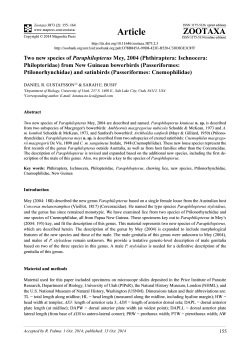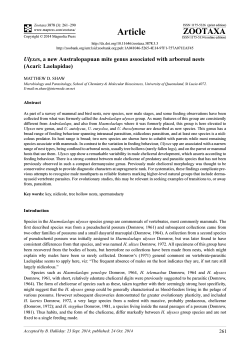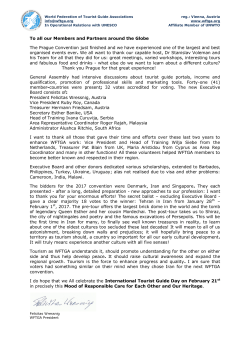
in Portable Document Format
Acta Zoologica Academiae Scientiarum Hungaricae 61(1), pp. 25–32, 2015 DOI: 10.17109/AZH.61.1.25.2015 TWO HETEROSTIGMATIC MITE SPECIES (ACARI: DOLICHOCYBIDAE, PODAPOLIPIDAE) ASSOCIATED WITH SCARABAEUS PIUS (COLEOPTERA: SCARABAEIDAE) FROM IRAN Bahramian, M., Hajiqanbar, H.* and Talebi, A. A. Department of Entomology, Faculty of Agriculture, Tarbiat Modares University 14115-336, Tehran, Iran. E-mails: morteza.bahramian20@gmail.com, hajiqanbar@modares.ac.ir and talebia@modares.ac.ir; *Corresponding author During a study on insect-associated heterostigmatic mites (Acari: Prostigmata) in southern Isfahan Province, Central Iran, two colonies of mites were found on Scarabaeus pius (Illiger, 1803) (Coleoptera: Scarabaeidae): Pavania lanceolata sp. n. Bahramian et Hajiqanbar (Dolichocybidae) that is easily discernible by some modified foliate setae on tarsi I–III; and Tarsopolipus massai Husband, 1989 (Podapolipidae) for which Scarabaeus pius is a new host record. Key words: Heterostigmatina, Pavania, Tarsopolipus, new species, host record. INTRODUCTION Beetles of the superfamily Scarabaeoidea are one of the most typical coleopterans, and even insects, to carry various kinds of mites. The mites from groups Mesostigmata, Prostigmata and Astigmatina encompass representatives associated with these beetles (e.g. Masan & Halliday 2009, Costa 1963, Oconnor 1982, Houck & Oconnor 1991, Bochkov & Klimov 2005, Kaliszewski et al. 1995). In Prostigmata, some heterostigmatic families such as Dolichocybidae (Hajiqanbar & Khaustov 2010), Scutacaridae (Ebermann et al. 2003), Pygmephoridae (Khaustov & Trach 2012), Microdispidae (Hajiqanbar et al. 2012) and Podapolipidae (Husband 1989) include species that have relationships with this group of beetles. Some mentioned families have only phoretic relationship with scarab beetles (like Dolichocybidae, Pygmephoridae and Scutacaridae) however, some others are parasite of their hosts (like Podapolipidae). The purpose of this paper is to describe a new species belonging to the genus Pavania associated with the Scarabaeus pius (Coleoptera: Scarabaeidae), compare the species with closely related congeners and report of the previously described species Tarsopolipus massai on the aforementioned scarab beetle, that provide a new host record for this parasitic mite. Hungarian Natural History Museum, Budapest 26 BAHRAMIAN, M., HAJIQANBAR, H. & TALEBI, A. A. MATERIAL AND METHODS Mites were removed from a scarabaeid beetle collected directly from their habitat, livestock dung pads. Mite specimens were cleared in lactophenol solution and mounted in Hoyer’s medium. Terminology follows mostly that of Lindquist (1986) and in part (chaetotaxy of tarsus I of the Pavania) Rahiminejad et al. (2011). The morphology of the mites was studied by a light microscope with phase contrast (Olympus BX51). All measurements in the description are given in micrometers for the holotype and four paratypes in parentheses. In descriptions of the leg setation the number of solenidia is given in parenthesis. Details of geographical coordinates have been recorded using GPS. The scarabaeid host beetle was identified by G. V. Nikolaev (Al-Farabi Kazakh National University, Almaty, Kazakhstan). The holotype is deposited in the Acarological Collection, Department of Entomology, Faculty of Agriculture, Tarbiat Modares University, Tehran, Iran. One paratype is deposited in the Collection of Department of Animal Taxonomy and Ecology, A. Mickiewicz University, Poznan, Poland, and an other paratype in U.S. National Museum of Natural History, Washington D.C., U.S.A. Host beetle is retained with the holotype. TAXONOMY Family Dolichocybidae Mahunka, 1970 Pavania lanceolata Bahramian et Hajiqanbar sp. n. (Figs 1–7) Diagnosis. The new species is characterized by some setae modified being foliate on the tarsi I–III (setae pv’, pv”, u’ and u” on the tarsus I; u’, tc”, pv’, pv” on tarsus II and pv” on tarsus III); dorsal idiosomal setae smooth, bluntended (except v2, sc2 and h2 pointed); seta c2 two times longer than c1; seta f at least three times longer than e; seta h2 about 6.8 times longer than h1; ventral idiosomal setae smooth and needle-like; pharynx obvious, with four muscle lobes on each side. Description. Female (holotype). Length of idiosoma 124 (128–128), width 76 (72–79). Gnathosoma (Figs 1–2). Length 23 (23–24), width 19 (21–23). Gnathosomal capsule subquadrangular in dorsal aspect, longer than wide. Cheliceral setae ch1 12 (13–13), blunt ended; ch2 6 (6–6), pointed. Dorsomedian apodeme apparent. Cheliceral stylets 6 (6–6) curved and falcate. Subcapitular setae su 5 (7–8), stiff and located on anterior half of subcapitulum. Pharynx visible with four muscle lobes (Fig. 3). Palpi evident, exceeding apex of gnathosoma capsule. Femorogenu with setae dGe 7 (7–9) and dFe 3 (3–3), both pointed; tibiotarsus with 2 solenidia; minute palpcoxal setae pp inserted near to articulation of each palp on gnathosomal capsule. Idiosomal dorsum (Fig. 1). Elliptic in shape. All dorsal shields ornamented with sparse dimples; posterior margins of C, D and EF shields with backward undulating projections. All dorsal idiosomal setae smooth. Prodorsal shield subtrapezoid, anterior margin convex, with setae v1 13 (12–14); v2 5 (4–5), sc2 49 (49–50). Trichobothridia (Sc1) present, broken in holotype and paratypes. Setae v1 shorter than distance between their bases and blunt, v2 short and located posterolaterally to v1, seta sc2 long and pointed. Median shield Acta Zool. Acad. Sci. Hung. 61, 2015 TWO HETEROSTIGMATIC MITE SPECIES (ACARI) FROM IRAN 27 of tergite C including setae c1 13 (12–12), each lateral shield with one seta c2 25 (22–25), both setae blunt; seta c2 2-times longer than c1. Tergite D bearing setae d 15 (14–15), blunt; cupuli ia situated laterally to seta d. Tergite EF with blunt setae e 8 (8–9) and f 27 (26–28), one pair of cupuli im placed anterolaterally to setae f, seta f more than 3-times longer than e. Tergite H with setae h1 9 (8-9) blunt ended and h2 61 (59–61) long and pointed, seta h2 about 6.8 times as long as h1. Distances between dorsal idiosomal setae: v1–v1 21 (22–23), v2–v2 27 (25–29), v1–v2 6 (8-9), sc2–sc2 35 (35-35), c1–c1 32 (30–33), d–d 52 (53–56), e–e 41 (43–45), f–f 33 (33–35), e–f 10 (10–10), h1–h1 13 (12–12), h2–h2 25 (23–25), h1–h2 8 (6–8). Idiosomal venter (Fig. 2). All ventral idiosomal setae smooth and needle like; apodemes II and III not reaching to presternal apodeme; apodeme IV joined to the poststernal apodeme. Coxal field I with setae 1a 5 (5–6), 1b 5 (6–6), 1c 5 (4–5). Coxal field II with setae 2a 12 (12–14), 2b 6 (5–6), 2c 12 (10–12); setae 2a and 2c subequal, both longer than 2b. Coxal field III with setae 3a 10 (8-11), 3b 8 (7–), 3c 10 (9–10); setae 3a and 3c subequal in length and both longer than 3b. Coxal fields IV with setae 4a 7 (7–7), 4b 8 (7–11), 4c 8 (7–9), all subequal. Figs 1–3. Pavania lanceolata sp. n., female: 1–2 = gnathosoma and idiosoma, 1 = dorsal view, 2 = ventral view (scale bars 50 μm); 3 = pharynx (scale bar 10 μm). Acta Zool. Acad. Sci. Hung. 61, 2015 28 BAHRAMIAN, M., HAJIQANBAR, H. & TALEBI, A. A. Genital plate with setae g1 2 (2–3) and g2 2 (2–2). Aggenital plates each bearing 1 seta ag 8 (6–7) and 1 small porous area. Pseudanal plate with setae ps 3 (3–4). Legs (Figs 4–7). All setae of the legs smooth. Leg I (Fig. 4): with pair of claws and short, sessile empodium; setal formula: 4–2–6(2)–11(2). Tarsus: with setae pv’, pv”, u’ and u” characteristically modified, lanceolate; setae tc’ and tc” subequal and longer than other tarsal setae; proral (p’, p”) and fastigial (ft’, ft”) setae subequal; solenidion 1 4 (3–4) finger shaped and prominent; solenidion 2 2 (2–2) baculiform. Tibia: with eupathidium k stiff, tapering; solenidion 1 6 (4–5) stalked and finger shaped, longer than baculiform 2 4 (3–4); seta d longer than other setae of the segment. Genu: setae v’ shorter than l’; seta l’ subequal to tibial sata l’. Femur: seta d subequal to tarsal setae tc’ and tc” and more than three times longer than l”. Leg II (Fig. 5). Setal formula: 2–1–4(1)–6(1). With pair of claws and large, stalked empodium. Tarsus: setae pv’, pv”, u’ and tc” characteristically modified, lanceolate; solenidion 3 (3–4) finger shaped; setae pl” and tc’ subequal. Tibia: solenidion 3 (2–3) similar to but thinner; seta l’ shortest on the segment. Genu: seta l’ subequal to tibial seta l’. Femur: seta d on femur about 2.5 times as long as seta v”. Leg III (Fig. 6). Setal formula: 1–1–4–5. With a pair of claws and large, stalked empodium. Tarsus: seta pv” characteristically modified, lanceolate; setae pl”and pv’ subequal and shortest on the segment. Tibia: setae v’ and v” subequal; seta d subequal to l’ and both shorter than v’ and v”. Genu: seta v’ subequal to tibial setae d and l’. Femur: seta d shorter than seta v’ on genu. Leg IV (Fig. 7). Setal formula: 1–1–4–5. With a pair of claws and large, stalked empodium. Tarsus: seta tc’ longest on the segment; setae pv’ and pv” subequal. Tibia: seta d and v’ subequal and shorter than other setae on the segment. Genu: seta v’ subequal to tibial seta d and v’. Femur: seta d shorter than other leg setae. Male. Unknown. Differential diagnosis. The species Pavania lanceolata Bahramian et Hajiqanbar sp. n. is readily distinguished from all other species of the genus by some modified lanceolate setae on tarsus I (pv’, pv”, u’, u”), tarsus II (u’, tc”, pv’, pv”) and tarsus III (pv”). Based on drawings of Mahunka (1975), at least, tarsus II seta u’ in Pavania endroedyi Mahunka, 1975 is foliate. Regardless of this trait, the new species is similar to its congeners Pavania fusiformis Lombardini, 1949; P. endroedyi and P. kamalii Hajiqanbar et Khaustov, 2010 in presence of trichobothridia and setae f longer than e. The new species differs from Pavania fusiformis by seta c2 twice as long as c1 (seta c2 less than twice as long as c1 in P. fusiformis), seta d longer than c1 (setae c1 and d subequal in P. fusiformis), seta sc2 about 3.5 times longer than c1 (seta sc2 about 2.5 times longer than c1 in P. fusiformis). The new species differs from Pavania endroedyi by seta c2 two times longer than c1 (setae c1 and c2 subequal in P. endroedyi), seta v1 longer than e (setae e longer than v1 in P. endroedyi), distance d-d longer than e-e (distance e-e longer than d-d in P. endroedyi). The new species also differs from Pavania kamalii by seta c2 twice as long as c1 (seta c1 longer than c2 in P. kamalii), seta f at least three times longer than e, (seta f about two times longer than e in P. kamalii), seta d longer than c1 (seta c1 longer than d in P. kamalii). Acta Zool. Acad. Sci. Hung. 61, 2015 TWO HETEROSTIGMATIC MITE SPECIES (ACARI) FROM IRAN 29 Figs 4–7. Pavania lanceolata sp. n., female, dorsal view of legs: 4 = I, 5 = II, 6 = III, 7 = IV (scale bars 20 μm). Acta Zool. Acad. Sci. Hung. 61, 2015 30 BAHRAMIAN, M., HAJIQANBAR, H. & TALEBI, A. A. Type material. Holotype (MB-20130508-1) and four paratypes, recovered from a vial containing ethanol (75%) and one specimen of Scarabaeus (Scarabaeus) pius (Illiger, 1803) beetle (Coleoptera: Scarabaeidae). The host beetle was collected from its habitat i.e. livestock dung pads, located in Iran, Southern Isfahan Province, near Semirom town, 31.26°N, 51.29 °E, 2,460 m, 8 May 2013, leg. M. Bahramian. Etymology. The new species is named due to lanceolate shape of some setae on tarsi I–III. Family Podapolipidae Ewing, 1922 Tarsopolipus massai Husband, 1989 Material examined. A large colony including all life stages of the mite from under the elytra of Scarabaeus (Scarabaeus) pius (Coleoptera: Scarabaeidae), the same host specimen as for Pavania lanceolata sp. n. Host beetle collected from livestock dung pads, Central Iran, Isfahan Province, around Semirom town, 31.26°N, 51.29°E, 2,460 m, 8 May 2013, leg. M. Bahramian. World distribution. Italy, Iran, France, Spain, East Africa. Remarks. This is a new association between this parasitic mite and the scarab beetle Scarabaeus pius. All previous host records of this mite are Scarabaeus semipunctatus reported by Husband (1989) in Italy, France, Spain and East Africa; by Hajiqanbar et al. (2007) in the vicinity of Galugah Forest, Mazandaran Province, northern Iran; and by Mortazavi and Hajiqanbar (2012) in Kerman Province, Iran. DISCUSSION The genus Pavania now includes 20 species of which 9 (c. 50%) are phoretic on 4 genera of Scarabaeidae: Copris, Onthophagus, Gymnopleurous and Scarabaeidae (Cross 1965, Sevastianov 1980, Hajiqanbar & Khaustov 2010, Rahiminejad et al. 2011, Loghmani et al. 2013, present study). Including Scarabaeus pius as a new host record for mites of the genus Pavania, the number of Scarabaeus species carrying mites of this genus is raised to 8 (see Table 1). All mentioned host beetles are dung dwelling as this habitat provides a rich source of fungi for mite nutrition. Although no life history of the species of Pavania has already been reported, they appear to be fungivorous in this substrate and, perhaps help in spreading fungi spores. There are five podapolipid genera parasitizing scarab beetles: Dilopolipus Husband, Archipolipus Husband, Stenopolipus Husband, Scarabapolipus Husband et Kurosa, and Tarsopolipus Berlese. Nine species of the genus Tarsopolipus are associated with three scarabaeid genera Drepanopodes, Kheper and Scarabaeus. Including S. pius, six species of Scarabaeus are exploited by mites of the genus Tarsopolipus. Heretofore, Tarsopolipus massai was found only on Acta Zool. Acad. Sci. Hung. 61, 2015 TWO HETEROSTIGMATIC MITE SPECIES (ACARI) FROM IRAN 31 Table 1. Current knowledge on mites of the genus Pavania associated with beetles of the family Scarabaeidae. Mite Host Locality Reference P. riparia Copris lunaris Linneaus, 1758 Ukraine, Slovakia Sevastianov 1980 P. tadjikistanica Onthophagus sp. Tajikistan Sevastianov 1980 Italy Cross 1965 P. fusiformis Scarabaeus sacer Linneaus, 1758 P. gymnopleuri Gymnopleuros mopsus persianus Iran Reitter, 1909 Hajiqanbar & Khaustov 2010 P. sabzevarensis Gymnopleuros mopsus persianus Iran Reitter, 1909 Hajiqanbar & Khaustov 2010 P. onthophagi Onthophagus gibbosus gibbosus Scriba, 1790 Iran Hajiqanbar & Khaustov 2010 P. kamalii Scarabaeus spp. Iran Hajiqanbar & Khaustov 2010 P. setiformis Onthophagus (Palaeonthophagus) vitulus (Fabricius, 1776) Iran Loghmani et al. 2013 P. lanceolata sp. n. Scarabaeus pius Iran this study Scarabaeus semipunctatus, however, the current study revealed Scarabaeus pius as a new host record for this parasitic mite. * Acknowledgements – We are grateful to Dr. G. V. Nikolaev (Al-Farabi Kazakh National University, Almaty, Kazakhstan), for identifying the scarabaeid beetle host. REFERENCES Bochkov, A. V. & Klimov, P. B. (2005) Three new species of the predaceous Cheyletidae (Acari: Prostigmata) phoretic on insects. Acarina 13: 15–22. Costa, M. (1963) The mesostigmatic mites associated with Copris hispanus (L.) (Coleoptera, Scarabaeidae) in Israel. Zoological Journal of the Linnean Society 45: 25–45. doi: 10.1111/j.1096-3642.1963.tb00485.x Ebermann, E. & Hall, M. (2003) First record of sporothecae within the mite family Scutacaridae (Acari, Tarsonemina). Zoologischer Anzeiger 242: 367–375. doi: 10.1078/00445231-00110 Hajiqanbar, H. & Khaustov, A. (2010) A new species group and five new species of the genus Pavania (Acari: Dolichocybidae) associated with insects, with notes on leg chaetotaxy and the distribution of genera. European Journal of Entomology 107: 441–453. doi: 10.14411/eje.2010.051 Acta Zool. Acad. Sci. Hung. 61, 2015 32 BAHRAMIAN, M., HAJIQANBAR, H. & TALEBI, A. A. Hajiqanbar, H., Husband, R. W., Kamali, K., Saboori, A. & Kamali, H. (2007) Ovacarus longisetosus n. sp. (Acari: Podapolipidae) from Amara (Paracelia) saxicola Zimm (Coleoptera: Carabidae) and new records of Coccipolipus, Dorsipes, Eutarsopolipus and Tarsopolipus from Iran. International Journal of Acarology 33(3): 241–244. doi: 10.1080/01647950708684528 Hajiqanbar, H., Rahiminejad, V. & Fathipour, Y. (2012) New insect host records for mites of the family Microdispidae (Acari: Heterostigmatina), with description of a new species of the genus Paramicrodispus. Entomological Science 15: 309–313. doi: 10.1111/j.1479-8298.2012.00515.x Houck, M. A. & Oconnor, B. M. (1991) Ecological and evolutionary significance of phoresy in the Astigmata (Acari). Annual Review of Entomology 36: 611–636. doi: 10.1146/annurev.en.36.010191.003143 Husband, R. W. (1989) A revision of the genus Tarsopolipus (Acari: Podapolipidae), parasites of African and European Scarabaeidae, with description of three new species. International Journal of Acarology 15: 163–178. doi: 10.1080/01647958908683842 Kaliszewski, M., Athias-Binche, F. & Lindquist, E. E. (1995) Parasitism and parasitoidism in Tarsonemina (Acari: Heterostigmata) and evolutionary consideration. Advances in Parasitology 35: 335–367. doi: 10.1016/S0065-308X(08)60074-3 Khaustov, A. & Trach, V. A. (2012) A new species and new records of mites of the genus Spatulaphorus Rack (Acari: Heterostigmata: Pygmephoridae) from Ukraine. International Journal of Acarology 38: 480–485. doi: 10.1080/01647954.2012.677475 Lindquist, E. E. (1986) The World genera of Tarsonemidae (Acari: Heterostigmata): a morphological, phylogenetic, and systematic revision, with a reclassification of familygroup taxa in Heterostigmata. Entomological Society of Canada 136: 1–517. doi: 10.4039/ entm118136fv Loghmani, A. Hajiqanbar, H. & Talebi, A. A. (2013) A new species group and species of the genus Pavania (Acari: Dolichocybidae), phoretic on Onthophagus vitulus (Coleoptera: Scarabaeidae) from Iran. Zootaxa 3693: 320–328. doi: 10.11646/zootaxa.3693.3.2 Lombardini, G. (1949) Acari nuovi. Redia 34: 67–74. Mahunka, S. (1975) Auf Insekten lebende Milben (Acari: Acarida and Tarsonemida) aus Afrika. V. Acta Zoologica Academiae Scientiarum Hungaricae 21(1–2): 39–72. Masan, P. & Halliday, B. (2009) Mesostigmatid mites associated with the dung beetle Copris lunaris (Coleoptera: Scarabaeidae). European Journal of Entomology 106: 545– 550. doi: 10.14411/eje.2009.068 Mortazavi, A. & Hajiqanbar, H. (2012) A new podapolipid species (Acari) on Scarabaeus (Scarabaeus) acuticollis (Insecta: Coleoptera: Scarabaeidae) from Iran. Journal of Parasitology 98: 746–753. doi: 10.1645/GE-3034.1 Oconnor, B. M. (1982) Evolutionary ecology of astigmatid mites. Annual Review of Entomology 27: 385–409. doi: 10.1146/annurev.en.27.010182.002125 Rahiminejad, V., Hajiqanbar, H. & Fathipour, Y. (2011) Redefinition of the genus Dolichocybe (Acari: Dolichocybidae), with description of two new species associated with insects. Annals of the Entomological Society of America 104: 627–635. doi: 10.1603/AN11006 Revised version received February 24, 2014, accepted December 20, 2014, published April 30, 2015 Acta Zool. Acad. Sci. Hung. 61, 2015
© Copyright 2025











